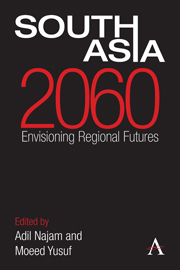Book contents
- Frontmatter
- Contents
- Acknowledgments
- List of Abbreviations
- Introduction: Imagining South Asian Futures
- Section I South Asia as a Region
- Section II State Relations
- Section III Development
- Section IV Human Well-Being
- Chapter 27 Population Dynamics, Economic Prospects and Regional Coherence
- Chapter 28 Towards Cooperation for Poverty Reduction?
- Chapter 29 Health Challenges
- Chapter 30 Regional Disease Dynamics
- Chapter 31 Education: Time Bomb or Silver Bullet?
- Chapter 32 Scholarship in and on South Asia
- Chapter 33 Rights and Justice: A Prospective View
- Chapter 34 Patriarchy, Power and Paradox: Dreaming Gender Equality and Development
- Chapter 35 Women in South Asia
- Chapter 36 Media: New Trends, Old Problems
- Chapter 37 Sports: Passion and Industry
- About the Authors
- Bibliography
- Index
Chapter 37 - Sports: Passion and Industry
from Section IV - Human Well-Being
Published online by Cambridge University Press: 05 September 2013
- Frontmatter
- Contents
- Acknowledgments
- List of Abbreviations
- Introduction: Imagining South Asian Futures
- Section I South Asia as a Region
- Section II State Relations
- Section III Development
- Section IV Human Well-Being
- Chapter 27 Population Dynamics, Economic Prospects and Regional Coherence
- Chapter 28 Towards Cooperation for Poverty Reduction?
- Chapter 29 Health Challenges
- Chapter 30 Regional Disease Dynamics
- Chapter 31 Education: Time Bomb or Silver Bullet?
- Chapter 32 Scholarship in and on South Asia
- Chapter 33 Rights and Justice: A Prospective View
- Chapter 34 Patriarchy, Power and Paradox: Dreaming Gender Equality and Development
- Chapter 35 Women in South Asia
- Chapter 36 Media: New Trends, Old Problems
- Chapter 37 Sports: Passion and Industry
- About the Authors
- Bibliography
- Index
Summary
Once you start thinking about it, it does not take long to appreciate that sports are essentially a vehicle for channeling primal urges – especially of competition and conflict – in a civilized manner. For that reason alone, South Asia as a region, with its long history of conflict and confrontation continuing into the present day, needs more sports.
Yet sports, today, are much more than that. They are a source of national identity and pride, a conduit for international exchange, a source of entertainment and of livelihood, an expression of self-esteem, a diversion and a distraction, and, ultimately, a major global industry and an integral part of national and global economies. Modern sports, collectively, are a behemoth.
The Legacy of Cricket
As with most things about South Asia, the region's relationship with sports has been heavily influenced by its colonial past. This is the primary reason one cannot talk very long about sports in South Asia without talking about cricket. Through the latter 1800s, as Englishmen posted in India began openly indulging in this most British of pastimes, native South Asians realized this was a game in which they could excel as well.
It is difficult to see Indians getting attracted to cricket as a leisure activity per se, for it is very much an acquired taste. Rather, a servant called upon to bowl at his English master in the nets would have discovered that if he cut the seam just so, and angled the delivery just so, and pitched the ball just so, then every now and then he would get past the edge of the master's bat to clip the off bail.
- Type
- Chapter
- Information
- South Asia 2060Envisioning Regional Futures, pp. 293 - 299Publisher: Anthem PressPrint publication year: 2013



